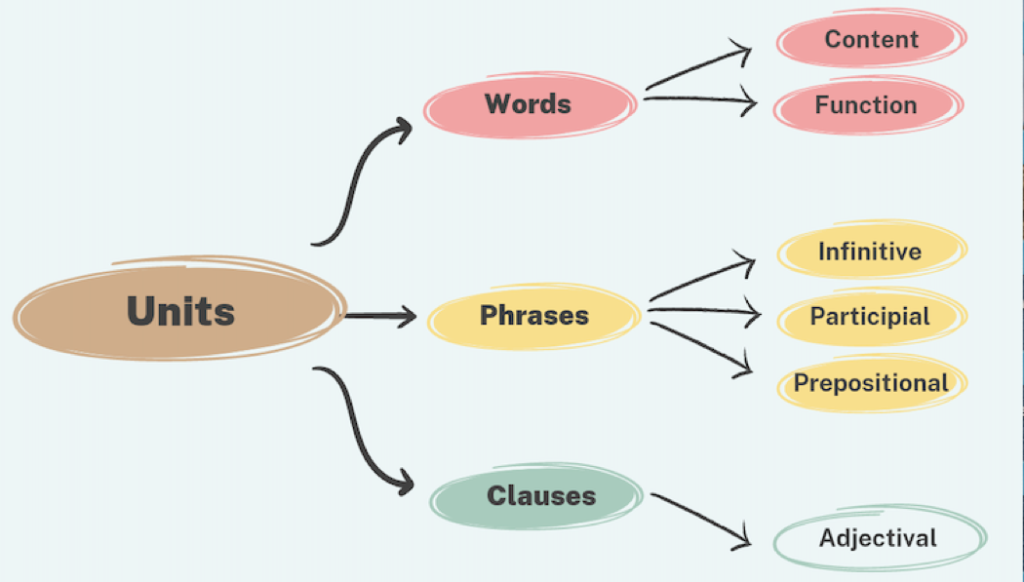Specification and Identification
Definition: the use of linguistic items to specify characteristics, attributes, identity, location, time, manner, etc., basically the specifying phrase adds more information to feel in the picture.
Modifiers are a sub-category of specifiers.
Point: Determiners/ articles/numbers are specifiers.
the book to be read is …
The man studying English(specification)(adjectival function, an adj adds more information) is my brother.
The man who is …..is my brother.

Words and morphemes (bound [suffixes/prefixes/gradation (give gave)]/ independent morphemes [words])
the two sides of the same coin
nominal phrase
verbal phrase
adjectival phrase
infinitive / participial (non-finite phrases)
non-
اﮔﺮ ﺑﺮاي modify ﮐﺮدن از ﮐﻠﻤﻪ(word) اﺳﺘﻔﺎده ﺷﻮد ﺑﺎﯾﺪ ﻗﺒﻞ از اﺳﻢ ﺑﯿﺎﯾﺪ در ﺣﺎﻟﯿﮑﻪ clauses & phrases ﺑﻌﺪ ازnoun می ایند:
Examples: of adjective fuction
The man in the class / the man having black hair / the man to come here
The man who come here /the tall man/ the fat man
• Adjectival clauses:
It is a clause which is used as the adjective.
اﯾﻦ clauses ﺑﺮ ﺧﻼف adverbial & noun clausesاﺧﺘﯿﺎرﯾﻨﺪ. ﯾﻌﻨﯽ ﻣﯽﺗﻮاﻧﻨﺪ از ﺟﻤﻠﻪ ﺣﺬف ﺷﻮﻧﺪ.
Example: The man who you introduced comes here.
I know the time when you study.
Noun + conjuncture + dependent clause
شکل کلی انها به این صورت است
ﻫﯿﭻ ارﺗﺒﺎط زﻣﺎﻧﯽ (tense dependence)ﺑﯿﻦ ﻓﻌﻞ ﻫﺎي main.cl. ﺑﺎ adj.cl. وﺟﻮد ﻧﺪاردconjunctures عبارتند از:
who/whom/which/that/when/why/how/what time/whose/where
دو ﻓﺎﮐﺘﻮر ﺗﻌﯿﯿﻦ ﮐﻨﻨﺪه ي ﻧﻮع conjuncture اﺳﺖ:
A. The noun modified.
B. The role of the noun in the adjectival clauses.
I saw the man. You introduced him last week.
Object
I saw the man who/whom you introduced last week.
ﭼﻨﺎن ﮐﻪ دﯾﺪﯾﻢ ﻣﻔﻌﻮل ﺣﺬف ﺷﺪه و ﺑﻪ ﺟﺎﯾﺶ ﮐﻠﻤﻪي ﻣﻄﺎﺑﻖ ﺑﺎ آن آﻣﺪه اﺳﺖ.
I went to the school. You teach there. I went to the school where you teach.
I know the hour. You study at 8. I know the hour when you study.
ﺗﻌﯿﯿﻦ conjunctures ﺑﺮ اﺳﺎس ﺟﺪول زﯾﺮ ﺻﻮرت ﻣﯽﮔﯿﺮد.
اﻧﺴﺎن/ﻏﯿﺮ اﻧﺴﺎن | Role | conjuncture |
اﻧﺴﺎن | Subjective | Who/That |
اﻧﺴﺎن | Objective of verb | Who/Whom/That/ Ø |
ﻏﯿﺮ اﻧﺴﺎن | Object of verb | Which/that/ Ø |
اﻧﺴﺎن | Object of preposition | whom |
ﻏﯿﺮ اﻧﺴﺎن | Object of preposition | Which |
ﻏﯿﺮ اﻧﺴﺎن | Subjective | That/ Which |
ﻏﯿﺮ اﻧﺴﺎن | Objective | That/ Which |
ﻏﯿﺮ اﻧﺴﺎن | Adverb of place | Where |
ﻏﯿﺮ اﻧﺴﺎن | Adverb of time | Where |
ﻏﯿﺮ اﻧﺴﺎن | Adverb of manner& method | How |
ﻏﯿﺮ اﻧﺴﺎن | Adverb of cause | Why |
ﻏﯿﺮ اﻧﺴﺎن | Adverb of propose | Why |
ﻏﯿﺮ اﻧﺴﺎن | ﺿﻤﯿﺮ ﻣﻠﮑﯽ | whose |
ﺑﻪ ﻃﻮر ﺧﻼﺻﻪ اﮔﺮ ﺑﺨﻮاﻫﯿﻢ d.cl. ﺑﺴﺎزﯾﻢ ﮐﻪ ﻧﻘﺶ adj داﺷﺘﻪ ﺑﺎﺷﺪ:
• ﺑﻌﺪ از اﺳﻢ اﺳﺘﻔﺎده ﺷﻮد.
• از conjuncture ﻣﻨﺎﺳﺐ اﺳﺘﻔﺎده ﺷﻮد.
• ﻫﯿﭻ ارﺗﺒﺎط زﻣﺎﻧﯽ (tense) ﺑﯿﻦ ﺟﻤﻠﻪي وﺻﻔﯽ و ﺟﻤﻠﻪي ﭘﺎﯾﻪ وﺟﻮد ﻧﺪارد.
• ﺣﺬف ﺿﻤﯿﺮ.
The book which/that has twelve seasons.
The man who/that came here yesterday
The fruits which ripen in the fall.
The food that contain mostly Carbohydrates.
The people who took part in demonstration.
The cars which have been produced/made in Iran after revolution.
The physics’ theories that/which have been rejected.
The theories that deal with social phenomenon.
The books that/which have been chosen/selected for teaching/ to be taught in this class.
The words which are there/are seen/exist in every lesson.
The man who has blond hair.
The woman who has blonde hair. The boy whose father talked to you.
The girl whose mother was angry with you.
The boy whose father looks daggers at you.
با عصبانیت نگاه کردن. چپ چپ نگاه کردن.
The school in which you teach.
The school which you teach in.
The school where you teach.
ﻧﮑﺘﻪ: ﻣﻔﻌﻮل ﺣﺮف اﺿﺎﻓﻪ و ﻏﯿﺮ اﻧﺴﺎن which می باشد.
اﮔﺮ ﻣﻔﻌﻮل ﺣﺮف اﺿﺎﻓﻪ ﺑﺎﺷﺪ ﺑﺮاي اﻧﺴﺎن از ﺣﺮف whom و ﺑﺮاي ﻏﯿﺮ اﻧﺴﺎن از which اﺳﺘﻔﺎده ﻣﯽﺷﻮد.
The man to whom you talked.
The man whom you talked to.
ﺣﺘﻤﺎ ﺑﺎﯾﺪ proposition ﻧﮕﻪ داﺷﺘﻪ ﺷﻮد. در ﻏﯿﺮ اﯾﻨﺼﻮرت ﻣﺒﻬﻢ ﻣﯽﺷﻮد. ﻣﺜﻼ در ﻣﺜﺎل ﺑﺎﻻﯾﯽ:
The man whom you talked
about در ﻣﻮردش/ ﻋﻠﯿﻪ آن: against / ﺑﻪ ﻧﻔﻊ: for / ﺑﺎﻫﺎشwith / ﺧﻄﺎب: to
ﺑﻨﺎﺑﺮاﯾﻦ ﻫﺮ ﻓﻌﻠﯽ ﮐﻪ ﺑﺎ ﺣﺮف اﺿﺎﻓﻪ ﺑﻮد ﺑﺎﯾﺴﺘﯽ ﺣﺮف اﺿﺎﻓﻪ ﻧﮕﻪ داﺷﺘﻪ ﺷﻮد و ﻗﺒﻞ از conjuncture ﯾﺎ ﺑﻌﺪ از ﻓﻌﻞ ﺑﯿﺎﯾﺪ.
The way how you study (adjectival function)
The time when you wake up/get up every day
The hour at which you get up
(you get up at 8)
اﮔﺮ at ﺣﺬف ﺷﻮد when ﻣﯽآﯾﺪ. در ﻏﯿﺮ اﯾﻦ ﺻﻮرت which at
The reason why you are talking to me (specification of the reason)
Most of students failed the test: The students most of whom failed the test/ The students some of whom failed the test
The tallest of the children is your daughter/ The children the tallest of whom is your daughter
You studied two of these books/ the books two of which you studied
The oldest teacher came here yesterday/ The teachers the oldest of whom came here yesterday
: Determiners
ﺟﻤﻠﻪ ي ﻋﺎم: ﺗﻤﺎم ﮐﺘﺎب ﻫﺎي دﻧﯿﺎ
Books are good
اﮔﺮ اﺳﻢ داﺷﺘﻪ ﺑﺎﺷﯿﻢ و ﺑﻌﺪ از phrase ﯾﺎ clause اﺳﺘﻔﺎده ﮐﻨﯿﻢ و آن ﻫﺎ را modifyﮐﻨﯿﻢ یک زیر مجموعه ﻣﯽ ﺳﺎزﯾﻢ. ﻟﺬا ﺑﺎﯾﺪ از determiner اﺳﺘﻔﺎده ﮐﻨﯿﻢ:
The book on the chair
The man who came here yesterday Students who came here جمله ی عام
ﺟﻤﻠﻪ ي ﻋﺎم ﺑﻪ theﻧﯿﺎزي ﻧﺪارد. اﻣﺎ ﺟﻤﻼﺗﯽ ﮐﻪ ﻣﯿﺨﻮاﻫﯿﻢ ﺧﺎص ﮐﻨﯿﻢ ﺑﺎﯾﺪ the ﺑﺪﻫﯿﻢ:
The students who come here (identifying phrase) are from Sabzevar.
Students who come here need English
اﺳﺘﻔﺎده از determiner اﺟﺒﺎر ﻧﺤﻮي ﻧﺪارد و ﻓﻘﻂ اﺟﺒﺎر ﻣﻌﻨﺎﯾﯽ دارد. اﮔﺮ ﻋﺎم ﺻﺤﺒﺖ ﮐﻨﯿﻢ ﺑﻪ determiner
ﻧﯿﺎزي ﻧﺪارﯾﻢ. اﻣﺎ اﮔﺮ ﺧﺎص ﺻﺤﺒﺖ ﮐﻨﯿﻢ ﺑﻪ آن ﻧﯿﺎزﻣﻨﺪﯾﻢ.
ﺧﺎص: The man who lives in Tehran is my friend: …مردی که در تهران
ﻋﺎم: A man who lives in Tehran must have a good income: … هر کسی که در تهران
اﺳﺘﻔﺎده ﯾﺎ ﻋﺪم اﺳﺘﻔﺎده از ﮐﺎﻣﺎ (,)
ﻗﺮار دادن ﮐﺎﻣﺎ ﺑﻪ ﺟﻤﻼت ﻗﺒﻠﯽ ارﺗﺒﺎط دارد. ﯾﻌﻨﯽ اﮔﺮ ﭼﯿﺰ ﯾﺎ ﮐﺴﯽ ﮐﻪ ﻣﯿﺨﻮاﻫﯿﻢ وﺻﻒ ﮐﻨﯿﻢ در ﺟﻤﻼت ﻗﺒﻠﯽ ﻣﻌﺮﻓﯽ ﺷﺪه ﺑﺎﺷﺪ، ﺑﻌﺪ از آن ﮐﺎﻣﺎ ﻣﯽ آﯾﺪ. در ﻏﯿﺮ اﯾﻦ ﺻﻮرت ﮐﺎﻣﺎ ﻧﻤﯽآﯾﺪ. (ﯾﮏ دﻟﯿﻞ ان اﯾﻦ اﺳﺖ ﮐﻪ ﮔﺎﻫﯽ ﻣﯿﺨﻮاﻫﯿﻢ ﺑﺎ وﺻﻔﯽ ﮐﻪ ﻣﯽ آورﯾﻢ ان را ﻣﻌﺮﻓﯽ ﮐﻨﯿﻢ. در اﯾﻦ ﺻﻮرت ﻧﺒﺎﯾﺪ ﮐﺎﻣﺎ آورد).
Yesterday I saw a man on the street. He was a teacher. The man…
در اﯾﻨﺠﺎ ﭼﻮن ﺧﻮاﻧﻨﺪه در ﺟﻤﻠﻪ ي ﺳﻮم ﻣﯿﺪاﻧﺪ ﮐﻪ man a ﮐﯿﺴﺖ. (ﻫﻤﺎن ﮐﺴﯽ اﺳﺖ ﮐﻪ در ﺧﯿﺎﺑﺎن دﯾﺪه ﺷﺪه و ﻣﻌﻠﻢ اﺳﺖ) ﺑﻨﺎﺑﺮاﯾﻦ اﮔﺮ ﺑﻌﺪ از آن ﺟﻤﻠﻪ وﺻﻔﯽ اﺳﺘﻔﺎده ﺷﻮد و ﺳﭙﺲ اداﻣﻪي ﺟﻤﻠﻪ، ﺟﻤﻠﻪي وﺻﻔﯽ را ﺑﺎ ﮐﺎﻣﺎ از ﻗﺒﻞ و ﺑﻌﺪ آن ﺟﺪا ﻣﯽﮐﻨﯿﻢ. ﺑﻌﺪ از ﮐﺎﻣﺎ ﺑﺎﯾﺴﺘﯽ ﻣﮑﺚ داﺷﺘﻪ ﺑﺎﺷﯿﻢ. ﯾﻌﻨﯽ در اداﻣﻪ ﻣﯽآﯾﺪ:
The man, who was very tall, told me that he lived in Tehran 20 years
اﻣﺎ ﻣﺜﺎل ﺑﺮاي ﻣﺮدي ﮐﻪ ﻧﮑﺮه اﺳﺖ:
The man who speaks English is my friend
(به کاما نیازی ندارد)
ﻧﮑﺘﻪ: ﺑﻌﺪ از اﺳﺎﻣﯽ ﺧﺎص ﻫﻢ ﮐﺎﻣﺎ
ﻣﯽآﯾﺪ.ﭼﻮن ﻣﻌﺮّﻓﻪ اﺳﺖ: Mr. Estiri,
ﻧﻘﺶ ﮐﺎﻣﺎ
1) وﻗﻔﻪ در ﺧﻮاﻧﺪن
2) اﻃﻼﻋﺎت ﺑﯿﺸﺘﺮ و ﺣﺎﺷﯿﻪ اي (ﻏﯿﺮ ﺿﺮوري)
ﺑﺪون ﮐﺎﻣﺎ ﯾﻌﻨﯽ اﯾﻨﮑﻪ ﺟﻤﻠﻪي وﺻﻔﯽ ﻧﻘﺶ ﺣﯿﺎﺗﯽ و ﺿﺮوري در ﺟﻤﻠﻪ دارد و اﻃﻼﻋﺎت ﻻزم را ﻣﯽدﻫﺪ.
ﻧﮑﺘﻪ: در ﻧﻮﺷﺘﻦ ﻣﻘﺎﻻت ﺟﻤﻼت وﺻﻔﯽ ﺑﻪparticipial phrase ﺗﺒﺪﯾﻞ ﻣﯽﺷﻮﻧﺪ.
ﻫﺮﮔﺎه ﻣﻔﻌﻮل ﻓﻌﻞ واﻗﻊ ﺷﺪ ﺑﺮاي اﻧﺴﺎن who/whom/that/Ø و ﺑﺮاي ﻏﯿﺮ اﻧﺴﺎن which/that/Ø اﺳﺘﻔﺎده
ﻣﯽﮐﻨﯿﻢ:
The rain the farmers were expecting came too late
The rain that/which the farmers were expecting came too late
The house where Taylors live is very old.
The house in which Taylors live is very old.
The house which Taylors live in is very old.
ﻧﮑﺘﻪ: رواﺑﻂ ﻓﺎﻣﯿﻠﯽ ﮐﻪ ﺑﺎ ازدواج ﺣﺎﺻﻞ ﻣﯽﺷﻮد: in law (ﻣﺎدرزن، ﭘﺪر ﺷﻮﻫﺮ، ﺑﺮادر زن)
ﻏﺴﻞ ﺗﻌﻤﯿﺪ ﺣﺎﺻﻞ ﻣﯽﺷﻮد: god ﺧﻮاﻧﺪه (ﭘﺪر-ﻣﺎدر)
ازدواج ﻣﺠﺪد اﯾﺠﺎد ﻣﯽﺷﻮد: step (ﻧﺎﺗﻨﯽ) ﺑﭽﻪ ﻫﺎ ﻫﯿﭻ واﻟﺪﯾﻦ ﻣﺸﺘﺮﮐﯽ ﻧﺪارﻧﺪ. brother Step
ازدواج ﻣﺠﺪد اﯾﺠﺎد ﻣﯽ ﺷﻮدhalf: ﺑﭽﻪ ﻫﺎ ﻓﻘﻂ ﯾﮏ واﻟﺪﯾﻦ ﻣﺸﺘﺮك دارﻧﺪ. brother Half

